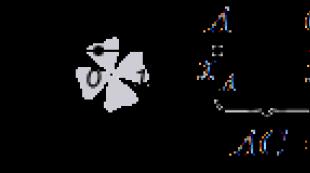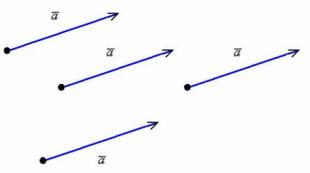Presentation on the Russian language scientific style of speech. Presentation on the topic "scientific style of speech". Scientific style has various kinds of clichés
Description of the presentation on individual slides:
1 slide
Description of the slide:
Features of the scientific style of speech Lesson of repetition and generalization of knowledge in the Russian language in grades 10-11 Vershinina L.V., teacher of Russian language and literature, secondary school No. 2, Neryungri
2 slide
Description of the slide:
3 slide
Description of the slide:
Speech styles Colloquial Book Scientific Fiction Formal business Journalistic
4 slide
Description of the slide:
Scientific style - one of the book styles of speech, used in scientific works, teaching aids, in oral presentations on scientific topics.
5 slide
Description of the slide:
Task: using the materials of the textbook (page ...), fill in the table Sphere of use Main functions Varieties of scientific style Genres Common style features Language means
6 slide
Description of the slide:
7 slide
Description of the slide:
Task number 1 Put punctuation marks, insert the missing letters, mark the grammatical forms characteristic of the scientific style of speech. Perform syntactic analysis of the sentence. The processes of nerve cells surrounded by .. (plasma) lem ... oh glial cells are called nerve fibers that form pathways in the brain and spinal ... brain and nerves on the per ... f ... rii.
8 slide
Description of the slide:
The processes of nerve cells surrounded by the plasmolemma of glial cells are called nerve fibers, which form pathways in the brain and spinal cord, and nerves on the periphery.
9 slide
Description of the slide:
Task №2 Indicate the word-formation element with which the terms are formed: Ultrasound, antimatter, drilling, drilling, antibody, irradiation, systematization.
10 slide
Description of the slide:
Task number 3. Perform text analysis. An excerpt from the report "The term as a semantic core of a special language" The main lexical and conceptual unit of a special sphere of language is a term. Possessing a number of specific features, it can only implement them within the terminological field. Terms, being the semantic core of a special language, have a certain independence of formation and development. The norm in terminology must comply with the norms of the general literary language and satisfy the special requirements that apply to the term. They are as follows: the systemic nature of the term, independence from the context, brevity and unambiguity of the term, as well as a certain degree of rooting of the term, its modernity, internationality and euphony. Reference material: a terminological field is an artificially delineated and specially protected area of existence of a term from extraneous intrusions.
11 slide
Description of the slide:
Plan for stylistic analysis of the text: Describe the situation of communication (conditions and tasks of speech) in which the text can be used. The purpose of the message. What are the main stylistic features reflected in this text: formality - ease, accuracy - vagueness of the name, impassivity - emotionality, concreteness - abstractness, objectivity - subjectivity, lack of imagery - imagery, emphasized logic, inviting speech. Indicate the language means (lexical, derivational, morphological, syntactic) with the help of which the stylistic features you named are revealed in this text. Decide what style the text belongs to.
12 slide
Description of the slide:
Possible answer: In the proposed excerpt from the report "The term as the semantic core of a special language", the goal is to objectively present accurate information about the main conceptual unit of a special sphere of language - the term, to prove its truth. Of course, the following main style features can be identified in it: formality, accuracy, concreteness, objectivity, emphasized logic. This fragment is connected with the orientation of a reader or a professional listener or a person interested in obtaining such information about the semantic core of a special language. Let us single out the language means by which the construction of the text is carried out. At the level of vocabulary, these are terms and compound terms-phraseological units: terminological field, systemic nature of the term; unambiguity of dominant words; frequent repetition of keywords: term, norm; lack of figurative (artistic) means. At the level of word formation, attention is drawn to the use of verbal nouns with suffixes –anii-, -enii-, which give an abstract meaning to words: rooting, requirement; nouns with the suffix -ost- (uniqueness, repetition, consistency, euphony). The morphological features of the fragment include the principle of economy of language means, the use of verbal nouns, verbs of the 3rd person singular. and many others. numbers, lack of pronouns I, you, verbs 1 and 2 persons singular. numbers, the absence of exclamatory particles and interjections. Syntactic features of the fragment: direct word order dominates, simple sentences prevail, complicated by isolated circumstances, expressed by adverbial phrases. Based brief analysis we can conclude that the excerpt from the report "The term as the semantic core of a special language" belongs to the scientific style.
13 slide
Description of the slide:
Homework 1. Describe any object in the office, observing the norms of the scientific style. 2. Write a miniature essay using Russian phraseological unit as a topic. For example: Sit in a puddle. One of the options for the completed task: What is the essence of the statement? Perhaps the point is the reaction of the ankle joint to the water during its sharp cooling. Let's take an inertial reference system, which will show that the phrase means a measured moral and ethical fall of a person? Moral degradation? Or a destructive effect on the puddle of the human body? Perhaps this is a question for research by a group of promising scientists. 3. Exercise 173 (stylistic analysis of the text)
- Slide 1. Scientific style. Analysis of style features. The scientific style of speech is one of the functional varieties of the literary language, serving the sphere of science and production; it is realized in book specialized texts of different genres.
- Slide 2. Science and scientific texts. Science is a peculiar sphere of human activity. It is designed to give true information about the world around. And although it is possible to comprehend the patterns of the surrounding world in other (not only scientific) ways, it is science that is turned to the intellect, to logic. Scientific texts are associated with an orientation towards a professional reader. So, the main features of the language of science are accuracy and objectivity.
- Slide 3. Composition of a scientific text. The composition of a typical scientific text reflects the sequence of phases scientific research: awareness of the problem (question, task) and goal setting - “introduction”, search for ways to solve the problem, enumeration of possible options and putting forward a hypothesis, proof of an idea (hypothesis) - “main part”, solving a research problem, getting an answer - “conclusion”.
- Slide 4. Language tools. In a scientific text in any specialty, one can easily single out the linguistic means by which this logical framework is constructed. These are, for example, verbs: let's designate, set, compose, define, find, choose, consider.
- Slide 5. Metatext. The scientific text has a complex organization. It can be conditionally divided into two layers in terms of what information the reader receives: factual, directly about the object of study; information about how the author organizes this factual information. Information of the second type (and the elements that introduce it) is usually called metatext. The presence of metatext is one of the essential properties of a scientific text.
- Slide 6. Objectivity and accuracy. The patterns of using linguistic means in a scientific style are determined by the factors that have already been mentioned - objectivity and accuracy.
- Slide 7. Objectivity. Objectivity implies that information does not depend on the whim of a particular person, is not the result of his feelings and emotions. In the text of a scientific work, it manifests itself both in the presence of some obligatory components of content, and in form - in the manner of narration.
- Slide 8. "Objectivity of form" of the scientific style. The “objectivity of the form” of the scientific style implies the rejection of language means that are associated with the transmission of emotions: interjections and particles that convey emotions and feelings, emotionally colored vocabulary and expressive sentence models are not used; a clear preference is given to a neutral word order; exclamatory intonation is not typical for scientific speech, interrogative intonation is used to a limited extent.
- Slide 9. Accuracy. Accuracy is an important feature of science. The scientific style in the mind of an ordinary person, of course, is primarily associated with terms.
- Slide 10. Terms. Terms do not exist one by one: establishing connections with each other - by the type of general / particular, genus / species, species / varieties, whole / part, identity, similarity, opposites, etc. - they form terminological systems.
- Slide 11. Scientific style variations. Depending on how the author defines for himself the capabilities and needs of his "interlocutor", he can use one of the variations of the scientific style: the scientific style itself, the scientific-educational or popular science substyle. The main variety is the actual scientific substyle. On its basis, a lighter version arises, intended for those who are just comprehending a new field of knowledge, a scientific and educational substyle. A small degree of competence of the reader or listener leads to the emergence of a popular science text.
- Slide 12. The main written genres. In the field of science, the main written genres are abstracts, an article and a monograph, since it is with their help that new scientific information is transmitted, other genres represent either a processing of this information that they provide, presenting information in an adapted, concise form (abstract, abstract), or give it an assessment (review, review).
- Slide 13. The rigor of the scientific style. The severity of the scientific style reaches its apogee in genres that are a document, and therefore are influenced by the official business style. Strict requirements are imposed on the final student work: the composition of the work is regulated (dividing into chapters or paragraphs, the presence of a plan (table of contents), sections "Introduction", "Conclusion" (or "Conclusions"), "Bibliography", and often "Appendix") , its design (indication on the title page of the details "Scientific supervisor", "Genre" (term paper, thesis, etc.), "Year", "Educational institution".
To use the preview of presentations, create a Google account (account) and sign in: https://accounts.google.com
Slides captions:
Scientific style of speech
Scientific style is a system of speech means serving the sphere of science and education.
Scientific style functions: communication of scientific information, scientific explanation of facts.
Characteristic features: consistency, objectivity, semantic accuracy, unambiguity, standardity, brevity, clarity, rigor, abstraction, generalization, impersonality, non-categorical.
Style features: Use of terms and unambiguous words, repetition of key words, direct word order, predominance of indefinite and impersonal sentences, abundance complex sentences, participial and participle turnovers.
Terms are one of two groups of special vocabulary - words and combinations of words used mainly by people of a certain branch of knowledge, profession. Each science has its own system of terms, called terminology.
There are three sub-styles: proper scientific (monographs, articles, dissertations, speeches in scientific disputes, scientific reports), scientific and educational (textbooks, lectures), popular science (popular science messages, articles, essays).
Self-scientific sub-style Immigration is now becoming one of the most important components of the life of Spanish society. Since the beginning of the new millennium, the country has demonstrated one of the highest growth rates in the world. Since 2000, 500 - 600 thousand people enter Spain annually. Currently, in terms of the influx of immigrants, the country ranks second in the world (after the United States) and first in Europe. According to the Ministry of Labor and Immigration at the beginning of 2008, the number of officially registered immigrants is 4.5 million people, and their total number (together with illegal immigrants) is estimated at 6 million people. At the same time, the share of immigrants in its population reached almost 10%. According to this indicator, Spain also leads among the countries of the European Union. Candidate of Economics, Senior Researcher Center for Iberian Studies I.G. Sinelshchikova Immigration and immigration policy in Spain: solutions, problems
Scientific and educational sub-style In the phonetic literature, one can find mention of 50 orthoepic and orthophonic features of the Leningrad pronunciation related to individual vowels and consonants, combinations of consonants and individual words. 39 of them are features of the Leningrad version of the norm and will be discussed below, 11 are features of the Leningrad vernacular, and therefore will not be analyzed. L.A. Verbitskaya "Let's speak correctly"
Popular science substyle Since the time of A.M. Peshkovsky, our linguistic science has come a long way. Rapidly developing, it sought mainly to create rigorous models and theories of language that could be applied in various computer systems for processing texts. But it is precisely this focus on solving applied, not directly related to human goals that has alienated modern linguistics from Everyday life from the interests of the common man. Elsa Florenskaya "On the style of a scientist"
The composition of a typical scientific text reflects the sequence of phases of scientific research:
1. Awareness of the problem (question, task) and goal setting - "introduction"; 2. Finding ways to solve the problem, sorting out possible options and putting forward a hypothesis, proof of an idea (hypothesis) - "the main part"; 3. Solving a research problem, getting an answer - "conclusion", i.e. the type of speech is reasoning.
To use the preview of presentations, create a Google account (account) and sign in: https://accounts.google.com
Slides captions:
SCIENTIFIC STYLE OF SPEECH OBJECTIVES: 1. TO GENERATE KNOWLEDGE ON THE TOPIC 2. TO GET ACQUAINTED WITH THE TERM "SCIENTIFIC SUBSTRATE" 3. TO LEARN TO RECOGNIZE THE MAIN FEATURES OF SCIENTIFIC STYLE OF SPEECH
Keywords: orthographic warm-up IA TIA, TOLERANCE, ATT ASHE, FEDERATIVE
INTERPRETATION OF THE WORDS CONJUNCTURE - the current situation, the current situation, the temporary situation in any area of public life; EMIGRATION - relocation from one country to another, caused by various reasons (economic, political, religious); REPATRIATION - the return to the homeland of prisoners of war, refugees, migrants; TOLERANCE - tolerance for other people's opinions, beliefs; IMMIGRATION - the entry of foreigners into any country for permanent residence.
THE HISTORY OF THE APPEARANCE OF THE SCIENTIFIC STYLE OF SPEECH MIDDLE AGES THE AGE OF FEODALISM "SCIENTIFIED LANGUAGE" LATIN The positive side: scientists from different countries could read each other's works. The negative side: this prevented the formation of a scientific style in each country.
THE FIRST SCIENTIFIC JOURNAL "JOURNAL OF SCIENTISTS" JANUARY 5, 1655 at the French Academy CURRENTLY - more than 50 thousand scientific journals
THE LANGUAGE OF RUSSIAN SCIENCE IN THE FIRST THIRD OF THE 18TH CENTURY - THE LANGUAGE OF SCIENTIFIC BOOKS THE MOST PERFECT SCIENTIFIC WORKS: M.V.
THE OBJECTIVE OF SCIENTIFIC STYLE is to clearly and clearly convey to the reader the reported information. SCOPE OF SCIENTIFIC STYLE Special literature Everyday life
GENRES OF SCIENTIFIC SPEECH STYLE Article; Monograph; Textbook; Patent description (description of the invention); Abstract; Annotation; Thesis; Lecture; Instruction
MAIN FEATURES OF THE SCIENTIFIC STYLE OF SPEECH
WRITE THE TEXT, PRINT SIGNS, INSERT THE MISSING LETTERS. DETERMINE THE STYLISTIC ACCESSION OF THE TEXT. PROVE.
The soil is a special pr..native body. It is formed ... on the surface of the Earth as a result of the interaction of living (organic) and inanimate (inorganic) pr..kind. In ... the most important property of the soil is ... fertility.
1. Form short passive past participles from these verbs: a) lead - b) continue - c) study - d) construct - 2. Determine the syntactic structure of the text by doing exercise. 368, part 2 “Organic chemistry as a science has been formed relatively recently....”
Check yourself No. 1. a) presented b) continued c) studied d) constructed. No. 2. a) complex sentences b) participial and adverbial phrases c) homogeneous members d) introductory words
"SCIENTIFIC SUBSTRATE" is actually scientific (dissertations, monographs, articles of scientific journals, GOSTs, encyclopedias, instructions); popular science (articles in newspapers, popular science magazines, popular science books; speeches on radio, television on scientific topics, specialists in front of a mass audience); scientific and educational (educational literature on subjects, reference books, manuals).
Read the text. Determine what style of speech it belongs to. Indicate the features of the style of speech: from the point of view of constructing the text, lexical morphological syntactic features. Name the terms. What role do they play in the text?
A .. a car is itself ... a vehicle designed (n) (nn) th for transporting goods of people and performing special operations. According to their purpose, they distinguish between cargo pa..azhirsky and special a..cars. According to the type of sha (s) (ss) and a .. cars are divided into frame and (without) frame. Frame cars have as a skeleton a frame to which components and m.. khanisms are attached. (Without) frame a..cars (do not) have frames, and the components and m..hanisms m..attach to the body. In this case, the body of a car is called n.. existing.
Choose the correct answer 1. The scientific style of speech is distinguished by: a) generalization a b) stereotype c) standardization 2. Scope of the scientific style of speech: a) speeches at rallies b) personal correspondence c) special literature c 3. Vocabulary features: a) stable combinations b) figurative means c) the unambiguity of the word in 4 , Syntax features: a) complicated simple sentences b) an abundance of complex sentences b
Content
1.
2.
3.
4.
5.
6.
The concept of scientific style
History of scientific style
Scientific style features
Scientific Style Traits
Conjunctions, prepositions in scientific style
Lexical features of the scientific style p
echi
7. Lexical unit in scientific style
8. Special lexical unit - term
9. Compound terms
10. Morphological features
11.Syntactic features
12. Sub-styles of scientific style
13. Genres of scientific style
style of scientific messages.
The scope of this style is
the science.
Its main function is to communicate
information, as well as evidence
her truth.
It is characterized by the presence of small
terms, general scientific words,
abstract vocabulary.
Content History of scientific style
The emergence of scientific
style is associated with the development
different areas of scientific
knowledge, different areas
human activities.
Style at first
scientific presentation was close
to the artistic style
storytelling.
It is known that too
"artistic" character
expositions of Galileo irritated
Kepler. Further
the model of scientific language has become
Newton's logical presentation.
Galileo Galilei
Content In Russia, the scientific language and
style began to take shape
first decades of the 18th century
when the authors of scientific books and
translators began to create
Russian scientific terminology.
In the second half of this
century thanks to the works of M.V.
Lomonosov and his students
formation of scientific style
took a step forward, but
he finally settled into
second half of the 19th century
together with scientific
activities of the largest
scientists of this time.
Content Scientific style features
Scientific style has a number of common
traits that appear regardless of
nature of certain sciences and
differences between genres
statements.
Content Features of scientific
style
Logic
Subsequence
Clarity
Content Active in scientific style
conjunctions, prepositions and prepositional
combinations that can
speak full words
First of all, nouns
with the help of, with the help of
conformity, as
as a result, because of
on the basis of, in relation to,
depending on..., in moderation,
compared to ..., in connection with ... and
other
Content Lexical signs of scientific
speech style
1.
2.
3.
4.
The abstract, generalized nature of the scientific
text is manifested at the lexical level in
that it widely uses words with
abstract meaning: function, disposition,
sequestration.
A characteristic feature of the scientific style is
its high termination
The language of science is characterized by the use
borrowed
And
international
models (macro, micro, meter, inter, graph etc.)
In the scientific style, nouns and
adjectives
from
certain
type
lexical meaning and morphological
characteristics.
Content Almost every lexical item
in scientific style denotes a concept or
abstract subject. Precisely and
unequivocally called special
concepts of the scientific sphere of communication and
reveal their content
lexical units - terms.
Content A term is a word or
phrase denoting a concept
special area of knowledge or
activities and being an element
certain system of terms.
Terms, most of which
are international words
is the conventional language of science.
Content Scientific style has its own
phraseology, including compound
terms:
right angle, inclined plane;
participial turnover,
compound sentence,
as well as various kinds of clichés:
consists in ..., is
..., consists of ... and others.
Content Morphological features
scientific style of speech
1.
2.
3.
4.
5.
Content
Specifically used in scientific style
verb.
Widespread in scientific texts
have short passive participles.
In scientific speech more often than in other styles
speech, short adjectives are used.
Peculiarly manifested in the language of science
category of person (not accepted in scientific speech
use the 1st person singular pronoun. h. I.
It is replaced by the pronoun WE)
In scientific speech, there are often forms
plural nouns,
which are not found in other types of speech abstraction and generalization
scientific speech is manifested in
peculiarities of use
verb aspect categories:
about 80% are forms
imperfect form, being more
abstractly generalized.
Content Syntactic features of the scientific
speech style
Modern scientific style
characterized by a desire for
syntactic compression.
Typical of this style is
the use of a nominal predicate.
Widely used in scientific
syntax are sentences with
brief participles.
Interrogative sentences perform
in scientific speech specific functions.
Content Scientific texts are characterized
complex sentences with different
union types.
For the style in question
characterized by widespread
impersonal offers.
Used in scientific speech and group
introductory words and phrases,
containing an indication of the source
messages.
Content For scientific style syntax
speech is characterized by a tendency to complex
constructions. For this purpose
offers are used with
homogeneous members and generalizing
words.
Content Scientific style substyles
Scientific.
Scientific and educational.
Popular science.
depending on how the author
identifies opportunities and
the needs of his "interlocutor", he
can use one of the variations
scientific style: actually scientific,
scientific and educational or popular science substyle.
Content Genres of scientific style of speech
The following genres can be distinguished
scientific prose:
monograph, journal article,
review, textbook, lecture, report,
informational message, verbal
speech, dissertation, scientific
report.
Content









